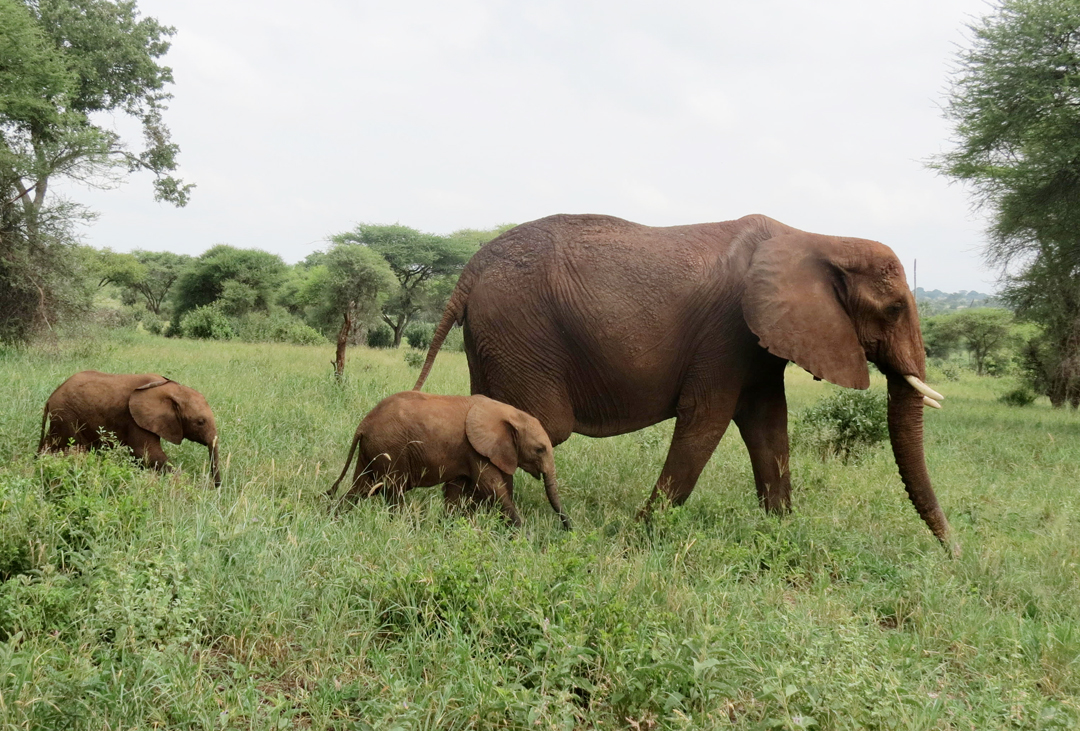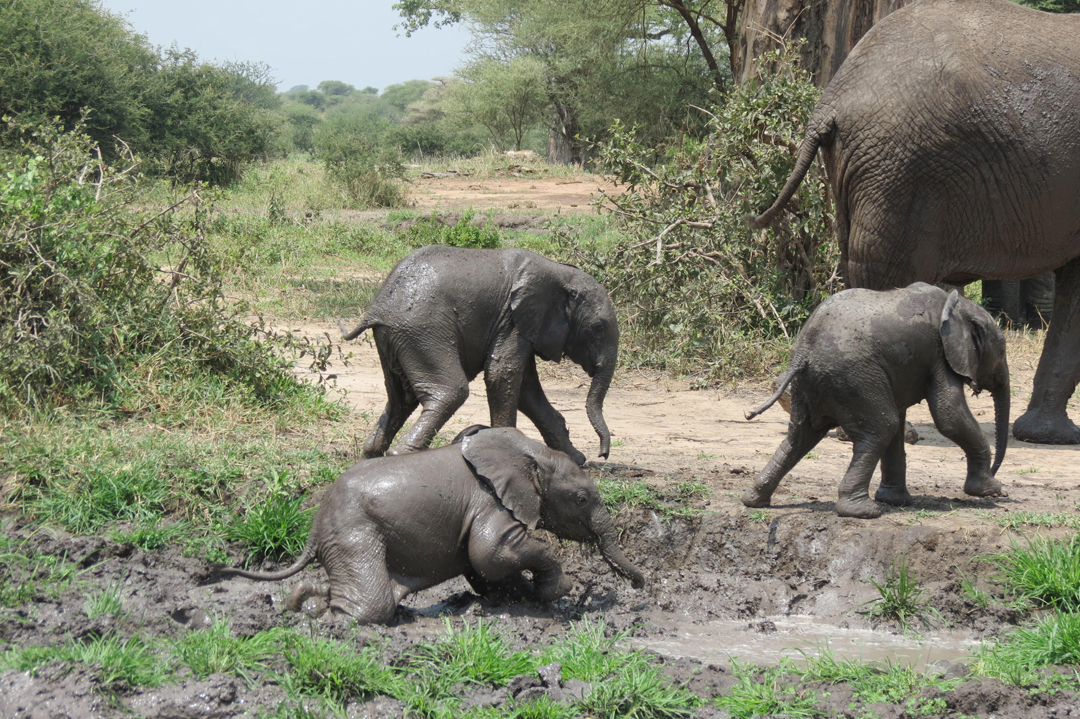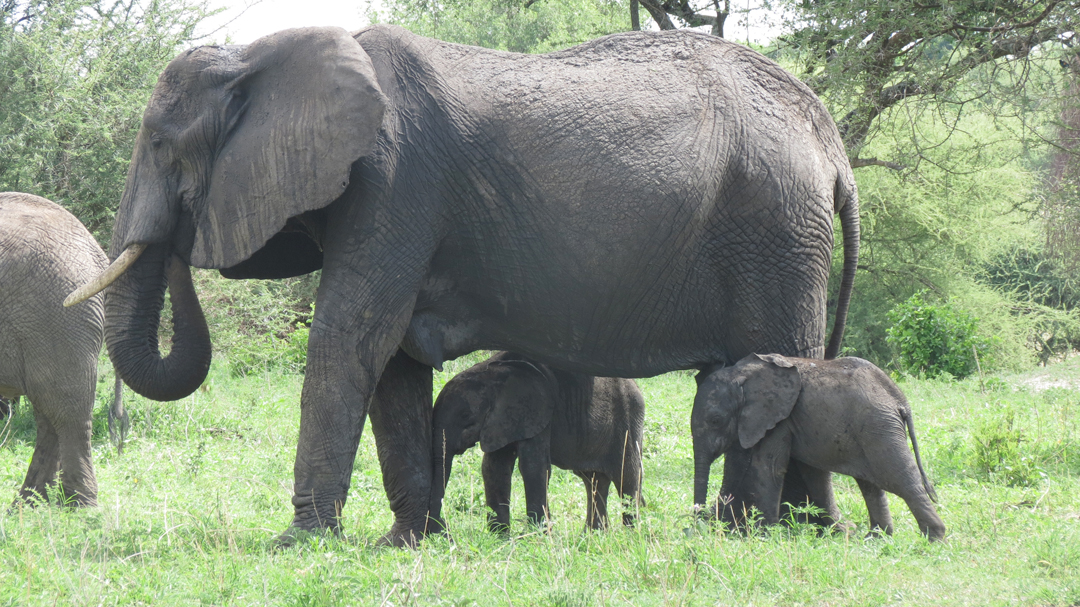Big, Beautiful, And Rare: Twin Elephants In Tanzania
At 57, their mother, Eloise, is the oldest known elephant to give birth to twins.
By Vicki Croke
The wise mother: Eloise, the 57-year-old matriarch, gave birth in August 2017 to twins who are thriving. Conservationists who monitor the group have named them “Elon Tusk” and “Emma” (after the actress Emma Watson).
Though it’s exciting to find twin elephant calves born among the wild group you study, Dr. Charles Foley, Director of the Wildlife Conservation Society’s Tarangire Elephant Project in Tanzania, was concerned the moment he met the two babies belonging to 57-year-old matriarch Eloise.
“The first time I saw them, when they were about three months old, they looked very thin and lethargic, and I wasn’t sure they were going to make it,” he says.
The odds were against them. Not many elephant conceptions result in twins in the first place—only about one percent. For the particular subpopulation Foley’s group monitors, these were the first recorded twins in 18 years. It’s then extra difficult to keep them alive. Among elephant twins, mortality rates are generally higher, according to WCS. A double challenge to provide for two babies at once.
Here & Now’s Lisa Mullins talked to Vicki Croke, host of WBUR’s The Wild Life blog.
So, Foley worried. But, as it turned out, the calves had drawn some lucky cards: A strong mother, early rains that brought out green grass, a home park with an enviable record of protection against poaching, and a set of siblings who seem happy to share their mother’s milk.
Today, the twins—brother, “Elon Tusk,” and sister, “Emma” (after the actress Emma Watson)—are 8 months old, playful, robust, and starting, in the words of Foley, “to pad out nicely.” They started off life at about 200 pounds each and are now perhaps 350 to 400 pounds, with Elon, the boy, bigger than his sister. Foley says that he and other members of the team “frequently see the two of them suckling happily at the same time.”

Only about one percent of elephant conceptions, according to Dr. Charles Foley of WCS, produce twins. Photo: WCS Tanzania Program.
Those peaceful nursing sessions are a particular relief. Twins can end up competing over resources, an especially troublesome situation with male calves who tend to be larger and have, as Foley says, “higher growth rates and greater milk demands.” The conservationist has been observing the elephants here for 25 years, and he has seen that a male can become aggressive toward his twin sister by “trying to prevent [her] from suckling.” In the cases in the past where this has been observed, “The females would simply wait until the males were sleeping, playing, or otherwise distracted before suckling.” Yet, perhaps surprisingly, it was the females in these situations who have tended to do better. “Despite monopolizing their mother’s milk, it was the male infants that proved to be most vulnerable,” Foley reports. “Among them mortality rates are quite high.” In the case of Eloise’s twins, Foley says, “the male has shown no aggression towards his sister.”
At 57, Eloise, “is probably the oldest female ever recorded having twins,” Foley says, and in general, female elephants start having fewer infants over the age of 50.
But older elephants are often wiser elephants. They’re experienced. And Eloise, whom Foley has followed for a long time, has had a lot to do with the progress of the twins. “We have recorded Eloise’s group every month or so for close to 25 years, with a few gaps when I was away from the field,” he says. “She is the matriarch of her group (the oldest and largest female), and because of her large size, she is one of the more dominant females in the population, meaning that her group seldom gets pushed around.”
This matriarch is judicious though. “All elephants have individual personalities,” Foley explains in an email, “and Eloise is very relaxed around vehicles and has never been aggressive towards us. However, she has no qualms about throwing her weight around with other, more subordinate elephant groups, and will readily displace them from waterholes or fruiting trees.”

Good mud and good friends: There are three other calves in the group for Elon and Emma to romp with. Photo: WCS Tanzania Program.
So the twins have a mother who can make sure they have access to food and water, and, at this point, the babies are feeding themselves as well as nursing. “Infants usually start feeding on grass at three months of age (to supplement suckling which they will do for 3-5 years),” Foley explains, “and we were fortunate that this year we had some good short rains, which provided lots of green grass for the twins to feed on. This helped them recover their body condition.”
Counting her own twins plus three calves recently born to other mothers, Eloise is the matriarch of a big group of 40 elephants. That’s one of the largest in Foley’s study population, though he says there are larger groups, including one with about 60 elephants.
Within Eloise’s group itself, there is plenty of help for the twins.
“Other females will provide general support such as protection and will generally fuss over the infants. Young females within the group that have yet to give birth will act as allomothers or ‘aunties’ to the youngsters, making sure they don’t get separated from the group, looking after them, and letting them suckle even though they don’t have any milk. Adult females rarely let other infants in their family group suckle from them—the energy requirements are simply too high.”
Elephant populations in Africa have been devastated by poaching, reduced by about thirty percent in just one seven-year period—from 2007 to 2014. And in Tanzania, it’s estimated that the elephant population fell by 60 percent in five years—from about 109,000 in 2009 to 43,000 by 2014.
But Tarangire National Park, Foley says, “is one of the safest Parks for elephants in Africa.” The park’s size, security, and its popularity with tourists help. He explains, “The Park is relatively small, has lots of tourists, and lots of Park rangers, and as a result there is very little elephant poaching in the ecosystem, even when the elephants leave the safety of the Park.”

Elon has shown no aggression toward Emma over nursing. Photo: WCS Tanzania Program.
In an important and comprehensive tally, “The Great Elephant Census funded by Paul Allen, that took place in 2014,” Foley points out that Tarangire was found “to be one of the few parks in Africa where the elephant population had increased” by more than five percent over a five year period. “We monitor a sub-section of the Tarangire elephant population numbering approximately 1,000 elephants, and, as best we can tell, none of these animals have ever been lost to poaching since the start of the study (although we do not monitor the bulls, so we don’t know what happens to them). The twins should therefore be as safe as they could be anywhere.”
Foley factors in the work of park rangers and local communities, as well as the experience and skill of Eloise for his sense of optimism about the twin calves. In a statement released by WCS, he said, “We have high hopes for their survival. Every elephant calf born is a step towards the recovery of the species, and twins are even better.”

4 Responses to “Big, Beautiful, And Rare: Twin Elephants In Tanzania”
How wonderful. How cute.
This is great news!Congratulations Eloise
Amazing, and prayers for safety for the elephants and their guardians alike!
Eloise and her twins, Elon Tusk and Emma give elephant lovers the world over hope for the continuing success of the amazing and beautiful African elephant species! Everyone is grateful for the humans who help keep them safe.
Comments are closed.